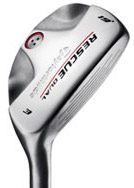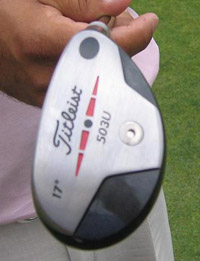 Hybrid clubs are an overnight success more than five years in the making. While these clubs – which combine design features of irons and woods into a small, fairway wood-like package – have caught fire at retail over the last year or so, they’ve been around for a while. And now that the big boys of the OEM world are getting into the game, it looks like the hybrids are more than hype.
Hybrid clubs are an overnight success more than five years in the making. While these clubs – which combine design features of irons and woods into a small, fairway wood-like package – have caught fire at retail over the last year or so, they’ve been around for a while. And now that the big boys of the OEM world are getting into the game, it looks like the hybrids are more than hype.
Hybrid iron-woods started out as an option for golfers who didn’t have the swing speed or skill to get their long irons airborne. Esthetically, they aren’t that different from the “bulger” woods of a century ago, sporting a clubhead that is relatively long from heel to toe and fairly compact. But, like most clubs in the bag, they have benefitted from recent changes in golf technology.
 Today’s crop of low-spin, high-launch golf balls actually made hybrids both feasible and, for a lot of golfers, necessary. The Pro V1s and HX Tours of the world fly great off a driver and shorter irons. But many golfers struggle to overcome the low-spin part of the bargain when hitting a long iron. It isn’t just hackers who have this problem as 1-irons have vanished from the tours.
Today’s crop of low-spin, high-launch golf balls actually made hybrids both feasible and, for a lot of golfers, necessary. The Pro V1s and HX Tours of the world fly great off a driver and shorter irons. But many golfers struggle to overcome the low-spin part of the bargain when hitting a long iron. It isn’t just hackers who have this problem as 1-irons have vanished from the tours.
The early precursors to today’s popular hybrids were driving irons like PRGR’s 200i, which was very popular on overseas tours in the late 1990s. The 200i looked like a long iron on steroids, with a beefy titanium shell and tungsten sole weights. The clubs never caught on at retail in the U.S., though.
A hybrid that did hold its own was Tour Edge’s Bazooka Iron-Wood. Introduced in 1999, the club has been a solid seller ever since. Initially, the company saw sales limited to high-handicappers.
As golf ball spin rates dropped, hybrid usage among low-handicappers started to rise. Initially, better golfers started adding utility woods, like 5- and 7-woods. While these clubs were easier to hit, they sacrificed some accuracy.
Enter the current generation of hybrids, which are often designed with better players in mind. The shaft length on a hybrid is shorter than a comparable fairway wood, making it more accurate. Yet the shaft is also longer than a comparable long iron, adding distance. Add in the fact that hybrids have a lower center of gravity than irons, and you have a new breed of clubs that has remarkably wide appeal.
This has given smaller companies like Tour Edge, Nickent, and Sonartec to make a name for themselves. Nickent’s 3DX hybrid has been used to win events on the PGA and Nationwide tours and now touts itself as the No. 1 hybrid company on tour. Meanwhile, Sonartec is still soaring after Todd Hamilton’s stunning British Open victory with the company’s Md hybrid last year. Hamilton showed the versatility of a hybrid, using his off the tee, from the fairway for punch shots and for playing long chips and bump-and-runs. The Sonartec Md is designed with better players in mind and has a low, iron-like trajectory – perfect for playing in the wind. You’ll see plenty of hybrids in play at St. Andrews this week.
As with any other trend worth mentioning, the industry’s big players are jumping in with both feet. Nike’s CPR hybrids and TaylorMade’s Rescue clubs were among the first big-name hybrids to hit the market. Callaway got into the market late last year with the Heavenwood hybrids, while Titleist added the iron-like 503.H to its lineup this year and Cleveland added the wood-like Halo hybrid.
 There are reports scattered across the Internet about prototype hybrids that may make it to golf shops soon. Ping, one of the last companies to enter the titanium driver fray, is also one of the last to not offer a hybrid. But Luke Donald has been spotted showing off a wood-like hybrid from the company. And Titleist has not one but two different hybrids in testing on tour: a 503.I that looks like a more traditional driving iron, and a 503.U with a more rounded, wood-like appearance.
There are reports scattered across the Internet about prototype hybrids that may make it to golf shops soon. Ping, one of the last companies to enter the titanium driver fray, is also one of the last to not offer a hybrid. But Luke Donald has been spotted showing off a wood-like hybrid from the company. And Titleist has not one but two different hybrids in testing on tour: a 503.I that looks like a more traditional driving iron, and a 503.U with a more rounded, wood-like appearance.
Meanwhile, Tour Edge is taking hybrid technology to the extreme with an entire set of hybrids now available. The Bazooka JMAX Iron-Woods range from 16-60°, and feedback has been strong. As the popularity of the Odyssey 2-Ball putter has proven, players will forgive an unusual design if the product performs.
I’ve had a 21° Sonartec Md in my bag since April. It replaced the 7-wood that replaced my 3-iron, and the hybrid has become one of my favorite clubs to hit. If you’re looking at hopping on the hybrid bandwagon, here’s some buying advice. Expect a hybrid to play shorter than a comparable wood and longer than a comparable iron. In my case, I hit my 7-wood 225 and my 3-iron 200. My Sonartec Md flies a reliable 210 yards on an iron-like trajectory, and with enough spin to hold the green.
Since some hybrids are more wood-like and others resemble irons, you can choose one that pleases your eye and fits your swing. If you like fairway woods, the Callaway and Cleveland hybrids might work best for you. If you’re more of an iron person, the Sonartec Md, TaylorMade Rescue Mid, Nickent 3DX, and Titleist 503.H might suit you better. In any case, I think you’ll find that your long irons and utility woods might soon find themselves gathering dust. Hybrids aren’t hype – they’re here to stay.
Photo Credits: © TaylorMade Golf, GolfWRX Forums.
